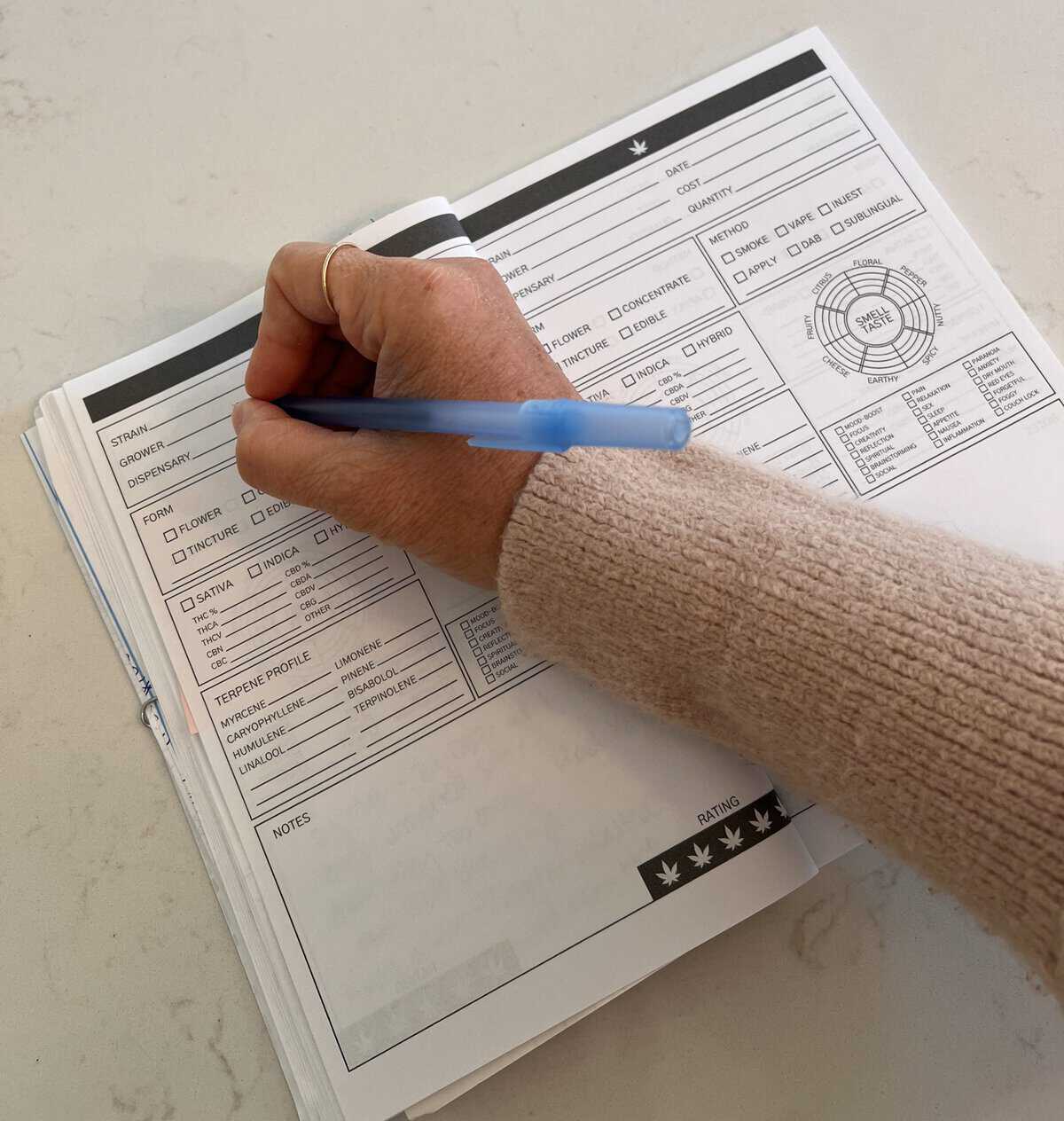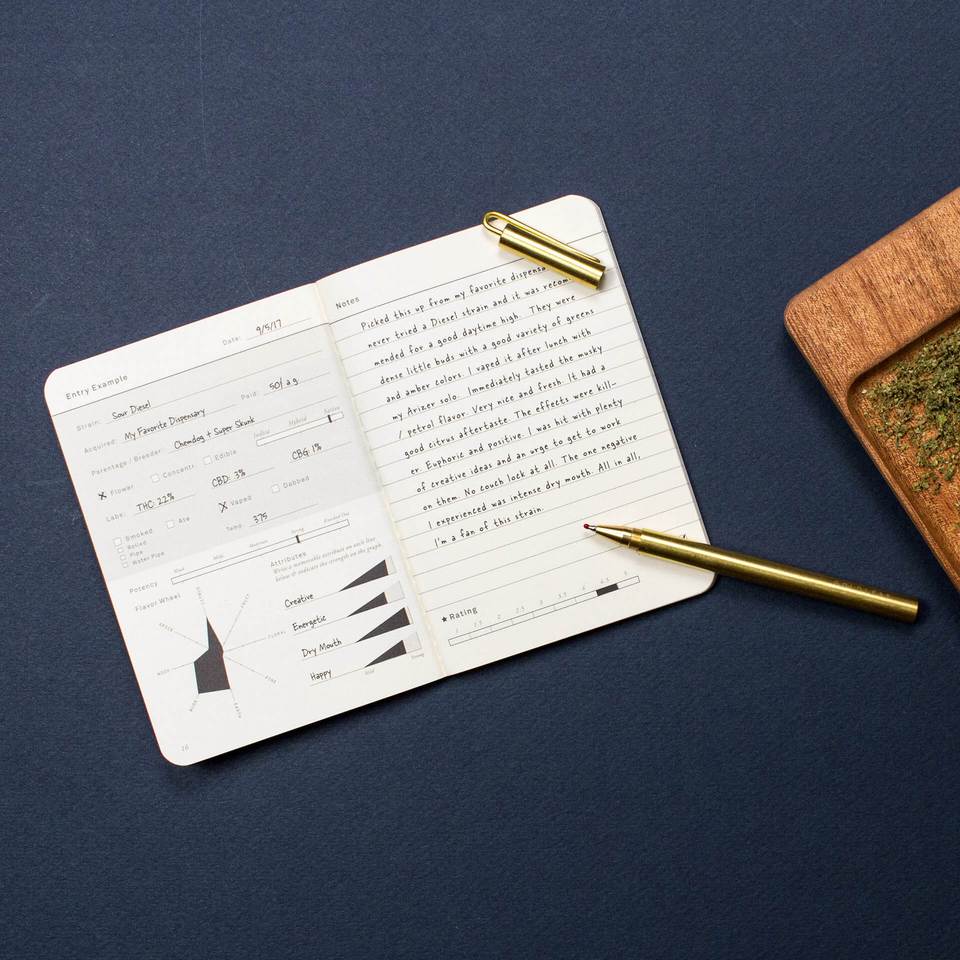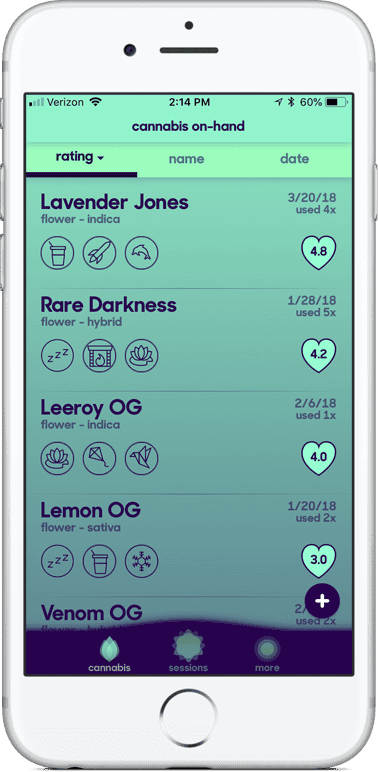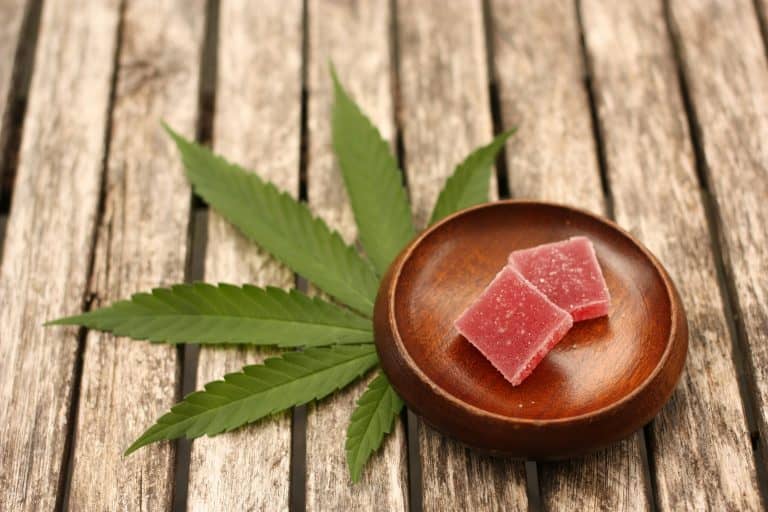Take Control of Your Cannabis Journey with a Strain Journal
Key Takeaways
This post may feature affiliate links. If something I write is useful to you, please order through the links on the page. It is no extra cost to you, and provides support that helps keep this site alive! Thank you! Disclosure policy.
Intro
If I had a dollar for every time a friend said, “My cousin gave me a gummy that made me waaaaay too high,” but doesn’t remember the product or how much they took,
Or, “weed is too unpredictable for me, sometimes it makes me feel so happy, and sometimes I get paranoid.”
Or, “I loved those little microdose mints I got in Colorado but now I don’t remember the brand,”
…I could buy myself a ticket to next year’s Hall of Flowers.
As a new cannabis user, or even as an old pro, using a cannabis strain journal or tracking app can make a HUGE difference in finding your sweet spot with cannabis.
It can help you narrow down what works for you, and avoid what doesn’t. It’s also super useful to use with budtenders at a dispensary, or with your doctor if you’re a medical marijuana patient.
Understanding the Importance of Cannabis Strain Journaling
The benefits of tracking your cannabis experiences
Tracking your cannabis use as a new user puts you in control of your experience.
Whether you had a fun, giggly, happy time (yay!), or a got-too-high-on-edibles-again time (oof), write it down!
It will make you a smarter consumer next time, so you can either repeat or avoid certain products.
Cannabis strain journaling is like being your own personal scientist. You’re tracking your experiences, noting the effects, and really getting to know how different strains, products, and doses work for you.
How journaling can help identify ideal strains for specific needs
There are hundreds of cannabis strains out there, but many of them have common chemical profiles. When you read what is in a strain and keep track of how it makes you feel, you’ll begin to narrow down what works best for you.
When I consistently tracked my cannabis strain use, I noticed that strains high in the terpene myrcene tend to help me sleep better. These were 3 different strains with 3 different names, but they all had myrcene in common.
Who knew?
Well, I did – thanks to my trusty journal! This kind of information is gold when you’re trying to find the right strain for specific needs.
Example of tracking entry
Here is an example from my own strain journal, the first time I tried the wonderful White CBG from Tweedle Farms.
Notice that I included where I got it, what it cost, what that CBG% was, what activity I did, and how it made me feel.
You can include as much or as little detail as you’d like.

Journal entry:
White CBG from Tweedle Farms $6/gram
CBG% 17.5 (has COA in folder)
“We took this Saturday morning of Norah’s bday party to be able to buzz around the house & clean but not get super high.
‘I don’t not feel it’ – more subtle than THC, but a nice mind shift, anxiety in chest gone, felt something. Nice body feeling but head only mildly high.”
Update – Good stuff! It does what CBD is supposed to – relaxed, slight head high.”
“What the heck is CBG?” you may be wondering after reading this journal entry? It’s CBD’s cooler cousin! CBG is a fabulous, non-intoxicating cannabinoid that is great for daytime focus. Read all about it in my article, “What is CBG? Your Secret Weapon for Focus and Sleep.”
Features to Look for in a Cannabis Strain Journal
User-friendly layout and design
Whether you’re using a paper journal or a tracking upp, you want it to be intuitive to use, with clearly labeled sections.
Think of it like a cookbook – everything should have its place. This makes it so much easier to maintain consistency in your entries, which is key for tracking your experiences over time.
Space for strain details (name, type, THC/CBD content)
You want room to note down the strain name, type (indica, sativa, or hybrid), and THC/CBD content. This information is gold when you’re trying to figure out patterns in your experiences.
Need to know the basic differences between strains? Be sure to read my article, Indica vs. Sativa vs. Hybrid Cannabis Strains EXPLAINED.
Space to record dosage and consumption method
This section is critical to your journaling.
Carefully record what product you took (take a picture of the label if it helps), how much you took, what time you took it, and how long before you felt it take effect.
The details matter, so be specific!
Section to track symptom improvement
Make sure there’s enough room to record how the product actually makes you feel!
Some journals even have mood trackers or symptom charts. These can be super helpful if you’re using cannabis for medical reasons or want to track how different strains affect your mood.
Section for noting aroma, flavor, and appearance
As you develop into a cannaseur, you may want to track the finer details of a particular strain, including aroma, flavor, and appearance.
I know it might seem a bit extra, but trust me, these sensory details can be super helpful.
I once reconnected with a strain I loved simply by recognizing its distinct piney aroma. It was like meeting an old friend!
Top 3 Paper-Based Cannabis Strain Journals for Beginners
Word Witchery Cannabis Strain Journal
This is the first strain journal I ever bought, and it is still a solid choice for beginners. It is simple, easy to use, and includes all of the key features a cannabis use diary needs.
I especially like the open “notes” box at the bottom that allows me to add any details that don’t fit neatly into cateogry.
Goldleaf Cannabis Taster Journal
Designed to spark your inner canna-suer, The Cannabis Taster facilitates your adventure through guided entry pages and graphics designed to help you document the flavors, effects, and potency of your cannabis experiences.
With thoughtful layouts and helpful terpene and flavor infographics, this journal will capture the details that let you fine-tune your strain and product selection.
Top 3 Digital Cannabis Tracking Apps for Beginners

Jointly App
“Cannabis AI in your pocket.” Yes please! The Jointly app optimizes your cannabis experiences through data-driven insights.
Jointly is great because it lets you choose how you want to feel (e.g. “create,” “improve everyday stress”) and suggests products based on that.
There is also space to capture your experience and view your data, plus cannabis strain reviews and recommendations from users.
Releaf App
Made in partnership with Americans for Safe Access, a medical cannabis advocacy group, the Releaf app offers a user-friendly interface with detailed tracking options.
The Releaf App helps you identify the most effective products, administration methods, and dosing practices for your needs and goals
How to Effectively Use Your Cannabis Strain Journal
Tips for consistent and accurate tracking
Consistency and timing are key when it comes to cannabis tracking.
If you’re working with a paper journal, keep it somewhere handy. If you’re using an app, keep it on your homescreen so you can easily access it.
Whichever method you use, be sure to track your use in the moment. Get the details right, take pictures of the product so you can get it again (or avoid it altogether!), and enter an accurate description of how it made you feel.
Using your journal to communicate with budtenders or healthcare providers
Your cannabis tracker isn’t just useful information for you, it can be incredibly valuable information for your budtender or doctor as well!
Instead of vaguely saying, “Uh, I tried something purpley last week and it was good,” you can provide specific details about strains, effects, and dosages.
It makes those conversations so much more productive as you work together to tailor your cannabis experience.
Feeling nervous about talking to a budtender? Get confident by reading my article, Your First Time? How to Shop at a Dispensary in 2024.
Conclusion
By keeping track of your experiences, you’re not just becoming a more informed consumer; you’re embarking on a journey of self-discovery in the fascinating world of cannabis.
With both print and digital options, it has never been easier to track your cannabis use.
Remember, the best cannabis strain journal is the one you’ll actually use. It might take some trial and error to find your perfect match, but trust me, it’s worth the effort.
Happy journaling, and may your cannabis experiences be as rich and varied as the strains themselves!













